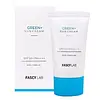What's inside
What's inside
 Key Ingredients
Key Ingredients

 Benefits
Benefits

 Concerns
Concerns

 Ingredients Side-by-side
Ingredients Side-by-side

Cyclomethicone
EmollientTitanium Dioxide
Cosmetic ColorantButylene Glycol
HumectantCaprylic/Capric Triglyceride
MaskingPropylene Glycol
HumectantEthylhexyl Methoxycinnamate
UV AbsorberCetyl PEG/PPG-10/1 Dimethicone
Emulsifying4-Methylbenzylidene Camphor
UV AbsorberZinc Oxide
Cosmetic ColorantParaffinum Liquidum
EmollientSorbitan Olivate
EmulsifyingMicrocrystalline Wax
Emulsion StabilisingButyrospermum Parkii Butter
Skin ConditioningDimethicone
EmollientCI 77492
Cosmetic ColorantSodium Hyaluronate
HumectantMagnesium Sulfate
Beeswax
Emulsion StabilisingCI 77491
Cosmetic ColorantCI 77499
Cosmetic ColorantAllantoin
Skin ConditioningBetaine
HumectantSodium Chloride
MaskingGlyceryl Caprylate
EmollientCaprylyl Glycol
EmollientTocopheryl Acetate
AntioxidantCamellia Sinensis Leaf Extract
AntimicrobialMorus Alba Bark Extract
Skin ConditioningGlycyrrhiza Glabra Root Extract
BleachingDisodium EDTA
Cyclomethicone, Titanium Dioxide, Butylene Glycol, Caprylic/Capric Triglyceride, Propylene Glycol, Ethylhexyl Methoxycinnamate, Cetyl PEG/PPG-10/1 Dimethicone, 4-Methylbenzylidene Camphor, Zinc Oxide, Paraffinum Liquidum, Sorbitan Olivate, Microcrystalline Wax, Butyrospermum Parkii Butter, Dimethicone, CI 77492, Sodium Hyaluronate, Magnesium Sulfate, Beeswax, CI 77491, CI 77499, Allantoin, Betaine, Sodium Chloride, Glyceryl Caprylate, Caprylyl Glycol, Tocopheryl Acetate, Camellia Sinensis Leaf Extract, Morus Alba Bark Extract, Glycyrrhiza Glabra Root Extract, Disodium EDTA
Water
Skin ConditioningButylene Glycol
HumectantC12-15 Alkyl Benzoate
AntimicrobialMethyl Methacrylate Crosspolymer
1,2-Hexanediol
Skin ConditioningDiethylamino Hydroxybenzoyl Hexyl Benzoate
UV FilterNiacinamide
SmoothingBehenyl Alcohol
EmollientBis-Ethylhexyloxyphenol Methoxyphenyl Triazine
Skin ConditioningPotassium Cetyl Phosphate
EmulsifyingSodium Acrylate/Sodium Acryloyldimethyl Taurate Copolymer
Emulsion StabilisingPolyisobutene
Ammonium Acryloyldimethyltaurate/Vp Copolymer
Silica
AbrasiveAdenosine
Skin ConditioningXylitylglucoside
HumectantCaprylyl/Capryl Glucoside
CleansingDisodium EDTA
Sorbitan Oleate
EmulsifyingAnhydroxylitol
HumectantXylitol
HumectantSodium Hyaluronate
HumectantGlucose
HumectantWater, Butylene Glycol, C12-15 Alkyl Benzoate, Methyl Methacrylate Crosspolymer, 1,2-Hexanediol, Diethylamino Hydroxybenzoyl Hexyl Benzoate, Niacinamide, Behenyl Alcohol, Bis-Ethylhexyloxyphenol Methoxyphenyl Triazine, Potassium Cetyl Phosphate, Sodium Acrylate/Sodium Acryloyldimethyl Taurate Copolymer, Polyisobutene, Ammonium Acryloyldimethyltaurate/Vp Copolymer, Silica, Adenosine, Xylitylglucoside, Caprylyl/Capryl Glucoside, Disodium EDTA, Sorbitan Oleate, Anhydroxylitol, Xylitol, Sodium Hyaluronate, Glucose
Ingredients Explained
These ingredients are found in both products.
Ingredients higher up in an ingredient list are typically present in a larger amount.
Butylene Glycol (or BG) is used within cosmetic products for a few different reasons:
Overall, Butylene Glycol is a safe and well-rounded ingredient that works well with other ingredients.
Though this ingredient works well with most skin types, some people with sensitive skin may experience a reaction such as allergic rashes, closed comedones, or itchiness.
Learn more about Butylene GlycolDisodium EDTA plays a role in making products more stable by aiding other preservatives.
It is a chelating agent, meaning it neutralizes metal ions that may be found in a product.
Disodium EDTA is a salt of edetic acid and is found to be safe in cosmetic ingredients.
Learn more about Disodium EDTASodium Hyaluronate is hyaluronic acid's salt form. It is commonly derived from the sodium salt of hyaluronic acid.
Like hyaluronic acid, it is great at holding water and acts as a humectant. This makes it a great skin hydrating ingredient.
Sodium Hyaluronate is naturally occurring in our bodies and is mostly found in eye fluid and joints.
These are some other common types of Hyaluronic Acid:
Learn more about Sodium Hyaluronate